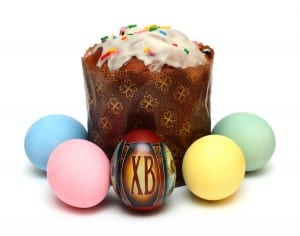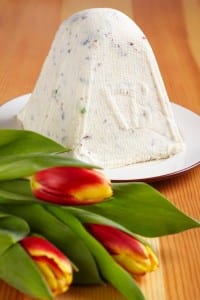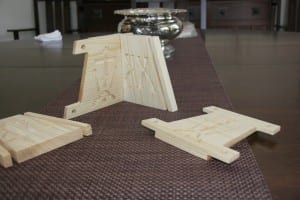Easter is just days away — Russian Orthodox’s most holy of holidays.
Orthodox Easter cuisine in Russia keeps pace with the liturgy’s potent symbols of resurrection, the triumph of light over darkness, and the return of spring. During Holy Week, Russians bake a light, dry traditional Easter bread, called kulich, and color and decorate hard-boiled eggs, which sadly fewer people these days seem to do in the traditional manner with the skin of yellow onions boiled in water. Orthodox Christians bring their eggs and kulich to their parish church for a Pascal blessing. Together with a sweet, rich, creamy curd cheese mold, spiked with spices, candied fruit, and citrus zest called paskha, these are the fundamentals of the Easter meal, right after the lengthy service, which culminates in the joyful Easter greeting “Xhristos Voskres!” or “The Lord Hath Risen!” to which the faithful respond, “He is Risen Indeed!” In Church Slavonic, this phrase is rendered by the Cyrillic letters “XB,” a motif which appears on eggs, kulich, and the paskha.
I remember my first Russian Easter as a frantic hunt, not for eggs and chocolate, but for bake ware. Although I have a sizable arsenal of pots, pans, pie and tart dishes, and other baking paraphernalia, none of them is suitable for the Easter confections. I wanted to do the thing properly: kulich is tall and cylindrical with a slightly puffy mushroom-like cap on top. Paskha is traditionally prepared in a special trapezoidal mold called a pasochnitsa decorated with elaborate “XBs” and Orthodox Crosses on each panel so that the chilled mold retains the imprint of these seasonal decorations.
In Russia, sourcing things never comes quite as easily as it does in the rest of the world. Figuring the pasochnitsa would be the harder of the two to run to ground, I started my search there. I prowled supermarkets and specialty kitchen stores to no avail. I checked the farmer’s markets and found nothing but got lucky with some local knowledge. Since the primary ingredients of paskha are cream, curd cheese, or “tvorog,” eggs, and butter, I threw myself on the mercy of the rosy-cheeked ladies who peddle these items at the market.
“Try the Churches,” they advised, leaving me wondering why I hadn’t thought of that simple solution. I’d got the scent, and after a slight detour to the three churches in my neighborhood and the Danilovsky Monastery gift shop, I headed strait towards the source: the Sofrino Ecclesiastical Store in Central Moscow where you can buy anything and everything having to do with the Russian Orthodox Church from a slim 2 ruble candle to a 13 million ruble marble baptismal font. There was one pasochnitsa there and I held my breath as four priests cut in line in front of me (apparently they can) to stock up on holy water and wedding crowns, but I was in luck, and, precious pasochnitsa in hand, I literally skipped down the stairs and out into the kitchen.
The kulich tin proved even more elusive. The church store didn’t have them. I trawled up and down the aisles of department stores and supermarkets. I found tube pans and charlotte moulds, both of which were too short, and baba cups, which were the right shape, but too small. Back at home, I burst into tears of frustration.
“What’s wrong?” asked my Russian husband. Hiccupping slightly, I explained that, thanks to my lack of a kulich tin Easter would be ruined – completely ruined. To my surprise, he burst out laughing. He disappeared into the pantry, still chuckling, then emerged with four metal tins of various sizes, which held tomatoes, coffee, beans, and pickled mushrooms.
“Kulich tins,” he said. I dried my eyes and let out a chuckle of my own.
“Kulich tins, indeed.”
Paskha:Ingredients:
Directions:
|
KulichIngredients
Directions
|
Priyatnogo Appetita!
—————————–
Dear Readers:
What’s on your Easter menu this year? Ham or lamb? Will you try a paskha or a kulich? If you don’t feel like going to the trouble of finding the equipment and baking, then try one of Moscow’s supermarkets or bakeries for these Easter delicacies.






I’m happy to have discovered your post I’ve misplaced the various handwritten recipes (from so & so elderly church lady and that little old church lady). However I’m not sure they’re such a great loss since all the pages had butter & flour stains & hand written notes in the margin where I necessarily tweaked the proportions of each ingredient. With every year the ink ran more & recipes became totally indecipherable!!! So I’m actually excited to start fresh. The kulich recipe sounds wonderfully rich. I applaud your generous use of Festal ingredients, such as cream & melted butter (after a 47 day fast, indeed rich & SOOO welcome!). I myself will be (eek) experimenting with panettone paper molds as well as a metal one, if I get it in time. Ive been wrapping heavy duty aluminum with paper bag paper & then cutting it to fit the cans. Tedious to say the least! Perhaps I missed this but approximately how many kulich I does your recipe make?? Thank you. And in anticipation..Христос Воскресе!! PS I applaud your idea of molding dough crosses for the top!! Wish I had thought of it earlier. (Prettier than using candied fruit!).
Hi Antonina!
This recipe makes about 2 large kuliches. I was delighted to discover springform kulich pans here in Moscow in all different sizes and shapes. What a wonderful way to do it! The panettone paper moulds will work, but sometimes they become a little tilted. Try also using a charlotte mold, which is the right shape anyway! In any case, thank you so much for writing! May your Easter be warm and happy!
Hi Jennifer,
Many thanks for your Paskha recipe! After 20 years in St. P and Moscow, find myself now ‘just’ a Russophile abroad (unexpectedly). Greetings and thanks from Warsaw for your Paskha recipe. Have several others, but yours is perfect for sourcing ingredients abroad.
See we have some mutual friends, regret we never met in Russia; love your blog!
Many thanks and happy Easter!